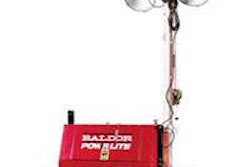Indiana DOT devised a way to avoid a prolong
shutdown of the Cline Avenue Bridge during
rehabiliation work.
by Floyd Engelking, Enerpac
The Indiana Department of Transportation (INDOT) found that it had a serious problem with its Cline Avenue (State Route 912) bridge over the Indiana Harbor Canal: salt damage.
Salt has been used for generations to deice roads, and it has undoubtedly prevented countless motor vehicle accidents.
However, it’s now widely recognized that road salt comes with a hidden cost, because it can damage steel and concrete, the principal materials of bridge construction. Although techniques such as using epoxy-coated rebar have provided some relief, the challenge remains.
In the case of the Cline Avenue bridge, the upper portions of concrete piers supporting the elevated roadway (six traffic lanes and two shoulders) had suffered considerable erosion
Engineers concluded that the top ten feet or so of the damaged piers would have to be removed and replaced.
The busy highway connects steel mills, casinos, and the cities of East Chicago, Gary, and Hammond, Indiana to the Indiana Toll Road (I-90), which in turn connects to the Chicago Skyway, so a prolonged shutdown would cause major problems. INDOT devised a fix that would keep the flow of traffic moving unimpeded during the rehabilitation work.
Removing the tops of the piers meant providing temporary support for the three concrete box girders carrying the roadway.
Contractor JCI Bridge Group erected a dozen temporary steel piers in clusters of four, braced and tied together, under each of the three box girders.
“The piers were fabricated from 30-inch diameter, 7/8-inch wall steel pipe, filled with sand” says Carl Tungate, P.E. of JCI adding, “The 54-foot tall piers sat on sill beams on the old footers.”
For a downloadable PDF of the full story, including photos and drawings explaining the process of the bridge replacement, please click here: Cline Avenue Bridge.







